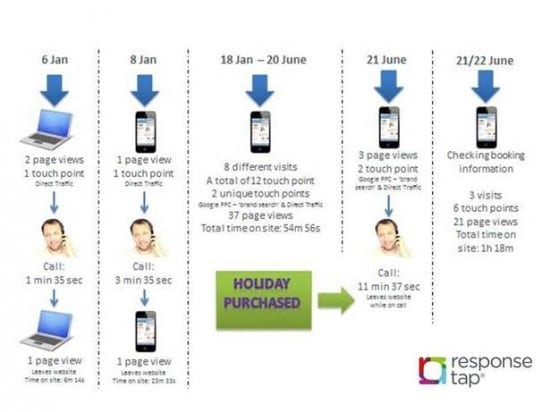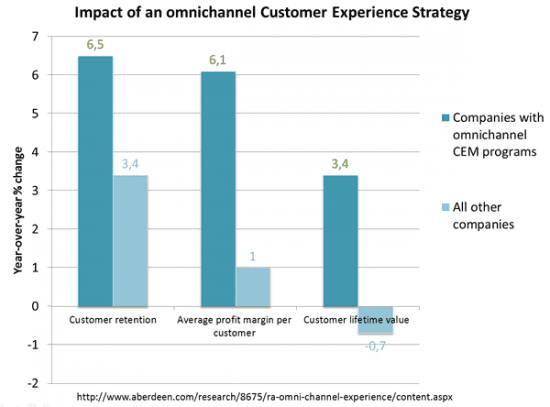Optimising and connecting customer touch points
Marketing expert Dr. Jeffrey Lant, says that in order to penetrate a consumer’s consciousness with your brand, and to make significant penetration in a given market, you have to make contact with the prospect a minimum of seven times. These seven “touch points” don’t have to be dedicated sales outreach, but refer to the different ways consumers interact with your brand: browsing your mobile site, for example is a touch point, as is receiving a flyer or trawling through your social channels.
Although this “Rule of Seven” is not absolute, it gives marketers an idea of the kind of effort and variety it takes to make an impression on a potential customer.
With the dawn of the digital age, the numerous channels and devices available for interaction mean that optimising each consumer touch point is more important than ever. It has also, more recently, become a marketing imperative for brands to ensure that these various touch points connect and tell a cohesive story. No longer is it viable to simply offer multiple different routes to purchase: today’s customers expect a fluid path to purchasing, which means connecting all the various channels to give the impression of single, bespoke purchasing path.
The following infographic highlights a fairly typical purchasing journey in the travel sector:

Omnichannel touch points
As the online life of consumers becomes richer and more complex, it seems all digital retailers are jumping on this “omnichannel” bandwagon. Its benefits are certainly clear to see: according to a report by report by Aberdeen Group, companies with omnichannel customer care strategies have 91 percent better year-on-year (YOY) customer retention rates than others. On average these companies also achieve an 8.5 percent YOY improvement in first contact resolution, a 7.5 percent YOY decrease in average cost per customer contact and a 9.5 percent YOY increase in revenue.

Providing consumers with an omnichannel experience seems to be mutually beneficial. Consumers are granted choice and feel completely in control of those choices, and this, in turn, usually helps companies to improve their conversion rates. However, as it stands, a number of businesses are failing to optimise one of the most important touch points of all: the phone.
The value of the voice when building brand advocacy
If we want to provide a true omnichannel experience, we need the right mechanics in place to ensure all offline channels – like the phone – are properly integrated. Although consumers may do most pre-purchase research based on their own initiative, a recent study from ResponseTap has shown the contact centre is still an essential part of the purchasing journey.
According to the report, 74 percent of US consumers like to speak to an agent in a contact centre before making a purchase, because it gives them confidence that they are getting exactly what they want. 64 percent of consumers also get frustrated when they are only able to engage with a brand online.
The offline world may be much more difficult to integrate into your omnichannel strategy – due to the absence of trackable data – however, when done right, the phone is one of the most effective channels for building loyal customers and advocates of the brand.
What follows is an outline of the most effective techniques for optimising the call centre touch point.
Leveraging online data to go omnichannel
According to a report from MIT, titled "Beyond the Checkout Cart", consumers will do most pre-purchase research on their own initiative: up to 80 percent of consumers are now so called “showroomers”, i.e. shoppers who check prices online before making a purchase.
Not much can be done to change this trend, and it is important to leave consumers to their own devices when it comes to research. However, if the contact centre is one of the most important channels for building brand advocacy then it pays to ensure the brand promise doesn’t collapse if the customer does decide to pick up the phone.
Connecting online and offline
The most effective way to ensure your contact centre fits seamlessly into a customer’s journey is to gather all the online data you know about a user and take it to the phone call. Conversion tracking gives us deep insights into our customers’ needs, so it make sense not to let the data go to waste as soon as the potential customer moves offline.
Employ Google Analytics and you can see the entire online journey that led up to the call: everything from search queries, keywords, to clicks and impressions, i.e. the user’s “digital footprint”.
The software
“Call Whispers”, a piece of software which feeds your contact staff information about a caller’s digital footprint, further ensure that as soon as a shopper moves offline they are given the impression of a seamless transition. The agent already has the consumer profile, can anticipate their questions and concerns, and is prepared to be the missing gap in the purchasing journey.
See my previous post for a review of alternative call tracking techniques and systems linking to a contact centre.
The holy grail of marketing automation
All marketing execs want to see when there message is getting through to consumers: they want to see when and where conversions are happening and to be constantly optimising their campaigns. But perhaps, when deciding how to manage marketing automation, there needs to be a shift in attitude – if companies really want to succeed in their omnichannel efforts they need think in a customer-centric way (i.e. ‘How does the customer want to interact with me?’) rather than projecting their own marketing objectives (i.e. ‘How do I want the customer to interact with me?’).
Ultimately what consumers want is choice, and the job of the marketer is simply to show up in the right places along the journey. Less is more with online retailing: present a clear and consistent brand message that bridges the gap between online and offline and customers will buy from you again and again.
The dream scenario
Imagine this scenario: someone has been researching a holiday in Greece and wants some advice from a staff member on which hotel to choose. Leveraging online data, the travel company is already aware of the customer’s needs and their call can be routed immediately to the agent who deals with Greece. This agent is then already clued in about the caller’s needs, making them much more likely to secure a sale.
This is the holy grail of marketing automation: the customer who has been researching Greek holiday destinations and deals online, gets rerouted to the right agent, they speak, and a purchase is made on the phone, with confidence.









